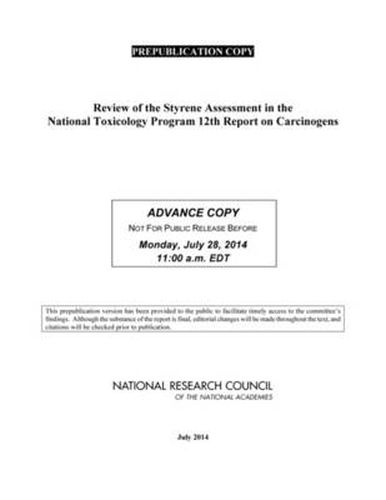Readings Newsletter
Become a Readings Member to make your shopping experience even easier.
Sign in or sign up for free!
You’re not far away from qualifying for FREE standard shipping within Australia
You’ve qualified for FREE standard shipping within Australia
The cart is loading…






Many people in the United States are exposed to styrene. Sources of environmental exposure included food (from migration of styrene from polymer packaging materials), cigarette smoke, vehicle exhaust and other forms of combustion and incineration of styrene polymers. Occupational exposure to humans can occur during the industrial processing of styrene. It is used to create a broad spectrum of products, including latex paints and coatings; synthetic rubbers; construction materials, such as pipes, fittings, and lighting fixtures; packaging; household goods, such as synthetic marble, flooring, and molded furnishings; and automotive parts. In 2011, the National Toxicology Program (NTP) listed styrene as reasonably anticipated to be a human carcinogen in its 12th Report on Carcinogens, marking the first time that the substance was listed. Congress directed the Department of Health and Human Services to arrange for the National Academy of Sciences to independently review the substance profile of styrene and it listing in the NTP report.
Review of the Styrene Assessment in the National Toxicology Program 12th Report on Carcinogens concurs with the NTP determination that there is limited but credible evidence that exposure to styrene in some occupational settings is associated with an increase in the frequency of lymphohematopoietic cancers. Additionally, the NRC report authoring committee independently reviewed the scientific evidence from studies in humans, experimental animals, and other studies relevant to the mechanisms of carcinogenesis and made level-of-evidence conclusions. Based on credible but limited evidence of carcinogenicity in traditional epidemiologic studies, on sufficient evidence of carcinogenicity in animals, and on convincing evidence that styrene is genotoxic in exposed humans, this report finds that compelling evidence exists to support a listing of styrene as, at a minimum, reasonably anticipated to be a human carcinogen.
$9.00 standard shipping within Australia
FREE standard shipping within Australia for orders over $100.00
Express & International shipping calculated at checkout
Many people in the United States are exposed to styrene. Sources of environmental exposure included food (from migration of styrene from polymer packaging materials), cigarette smoke, vehicle exhaust and other forms of combustion and incineration of styrene polymers. Occupational exposure to humans can occur during the industrial processing of styrene. It is used to create a broad spectrum of products, including latex paints and coatings; synthetic rubbers; construction materials, such as pipes, fittings, and lighting fixtures; packaging; household goods, such as synthetic marble, flooring, and molded furnishings; and automotive parts. In 2011, the National Toxicology Program (NTP) listed styrene as reasonably anticipated to be a human carcinogen in its 12th Report on Carcinogens, marking the first time that the substance was listed. Congress directed the Department of Health and Human Services to arrange for the National Academy of Sciences to independently review the substance profile of styrene and it listing in the NTP report.
Review of the Styrene Assessment in the National Toxicology Program 12th Report on Carcinogens concurs with the NTP determination that there is limited but credible evidence that exposure to styrene in some occupational settings is associated with an increase in the frequency of lymphohematopoietic cancers. Additionally, the NRC report authoring committee independently reviewed the scientific evidence from studies in humans, experimental animals, and other studies relevant to the mechanisms of carcinogenesis and made level-of-evidence conclusions. Based on credible but limited evidence of carcinogenicity in traditional epidemiologic studies, on sufficient evidence of carcinogenicity in animals, and on convincing evidence that styrene is genotoxic in exposed humans, this report finds that compelling evidence exists to support a listing of styrene as, at a minimum, reasonably anticipated to be a human carcinogen.